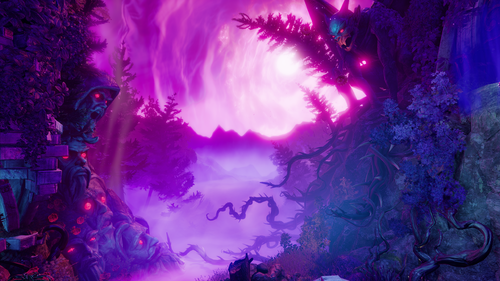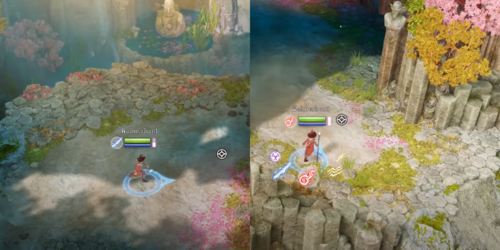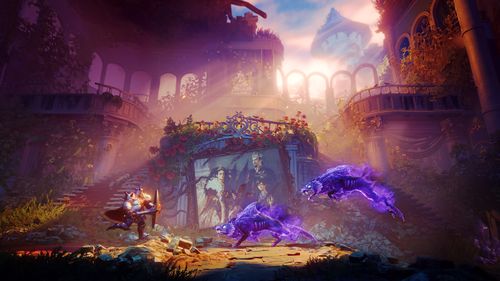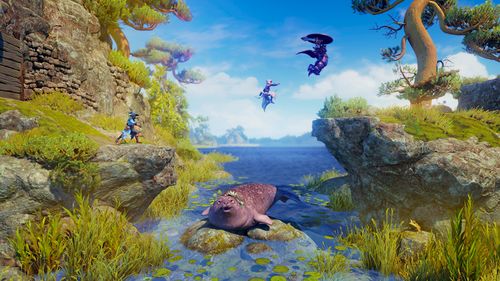Difference between revisions of "Level Art: Environmental Storytelling"
m (Tero Tirkkonen moved page Public Level Art: Environmental Storytelling to Level Art: Environmental Storytelling without leaving a redirect) |
|
(No difference)
| |
Revision as of 15:47, 23 November 2021
Contents
What is Environmental Storytelling?
- An environment is an imagined space where the player moves inside.
- Even though the environment is virtual, it creates boundaries and limitations for the player and guides them through using tools such as lighting and art.
- As the player moves around in the virtual world and passes through the different rooms and scenes, they're given context through carefully placed props and objects.
- Every asset in a scene has a purpose, every character is placed there for a reason and every piece of background art has a history.
- Environmental details mirror and expand the lore of the world, offer additional information about locations or characters, and deepen the player's understanding of the story.
- In other words, the player's view of the world and understanding of the narrative is shaped by where they find themselves in that world.
- The rich environmental details supported by the narrative and supporting the narrative help the player see the game world as one whole (even when it's separated in levels like in Trine).
- To achieve immersion careful planning and much work are needed: placing all props carefully, designing NPC looks and locations to reflect their personalities, occupations and residence, creating areas where the mood and the atmosphere complement each other - essentially, making all the elements of the game work together.
- Once the immersion is achieved, everything seems in place, and all things belong. The player can't help but to feel that things make sense, however curious or outlandish the various elements might be.
- In an immersive game, barriers in the environment need to make sense within the game world - to the point that players will never even question why they can't get past an obstacle.
How does Environmental Storytelling work?
- It's a mixture of direct references and more vague things.
- When inserting an apparent story reference, you should always consult the writer to ensure the environmental storytelling aligns with the screenplay.
- Environmental storytelling works better the more freedom the player has. Trine is usually focused on linear exploration, but that doesn't mean it can't benefit from environmental storytelling.
- Each and every scene is distinctive while at the same time retaining the style of the level, both design- and art-wise.
- This makes it easier for the player to build a mental map of the level and imagine how things work outside their immediate view.
- When building the levels, you don't need to think about making them more realistic, but simply remember how Trine's fictional world works and use it as a springboard.
- Things that don't make sense in real life could make perfect sense in Trine's land of fantasy.
- The exploration process wheels more organic when a player receives the expository information through their eyes and ears and via the world itself (as opposed to just listening and reading it from text boxes, dialogues or cutscenes).
- When the story is perceived through observation, the narration is reinforced. The game world feels more believable and alive to the player.
Examples of Environmental Storytelling
- How environmental storytelling translates to both the environment itself and into gameplay:
- This scene set in The Astral Nightmare is a good example of successful environmental storytelling.
- On one side are the wizards, scared and angry. On the other side, there's the true form of The Nightmare Prince.
- Even though the player hasn't met the Nightmare Prince, they have a clear idea of what the wizards were like towards Selius. The scene also foreshadows what will happen later, namely the Selius transformation during the game finale.
- It serves as a sort of an Easter egg for those people playing the game a second time.
- The visuals connect nicely to the main narrative, showing us Astral Academy (Selius's personal purgatory) and the main character
- Elves have never been mentioned in the Trineverse, but this level has statues depicting them.
- Players noticing the statues and other remains of the elvish culture learn more about the Trineverse world & can immerse themselves in the world.
- The elven statues aren't connected to the main narrative itself, since the elves play no role in it. Their "presence" in the environment, however, helps to develop and expand the world and lore.
- This scene shows a family portrait of the Heatherwood family, but it's been ruined by one of Selius's Nightmares.
- A book found later in the level reveals that Selius was bullied by his brothers. Players probably see the painting in a new light, especially since the part of the painting depicting Selius's brothers is badly damaged.
Environmental Storytelling and Design
- It's crucial to communicate constantly with the designers. When creating level art, the gameplay and design aspects need to be considered. Sometimes it means trying to match far-out and crazy gameplay ideas to the overall visuals as seamlessly as possible.
- Due to Trine's 2.5D nature, players don't have a lot of freedom deciding where to go and what to interact with. It's the level artist's job to make sure that the only route the players can take feels like the obvious and tempting choice and not a forced necessity.
- That's been achieved by making the background and foreground areas (where the players can not move) seem uninviting, too hard to navigate, or outright dangerous.
- It's also very important to add art assets to puzzle elements to tie them together with the surroundings and the level.
- Here's how the environmental storytelling translates to the gameplay: instead of having a wooden gate the slides to the side, a strong grip of the enchanted vines has been chosen to break the stone wall.
- This doesn't seem out of place in the context of the level and makes both the story and the gameplay more coherent.
- The Seal in T4 is a fantastic example of the art, story and gameplay blending together.
- It appears throughout the whole lake level and helps the heroes. In return, the heroes assist The Seal. Later, it's mentioned by Elodea when we meet her.
- All pieces are connected and work beautifully together, giving the Seal a greater purpose in the game world (rather than being just a bouncy gameplay prop).
In Conclusion
- Environmental storytelling is a great way to make the game's story more interesting.
- As there is a whole Trineverse world featured in several games, it's important to make the games feel connected, even if each entry to the series is a stand-alone game.
- The players are already familiar with the world and its characters, so adding emotional impact will make them even more immersed in the game world.
- With future projects, we can revisit the old Trineverse locations, creating a wonderful sense of nostalgia (art, music, feel), while keeping things new and fresh.



